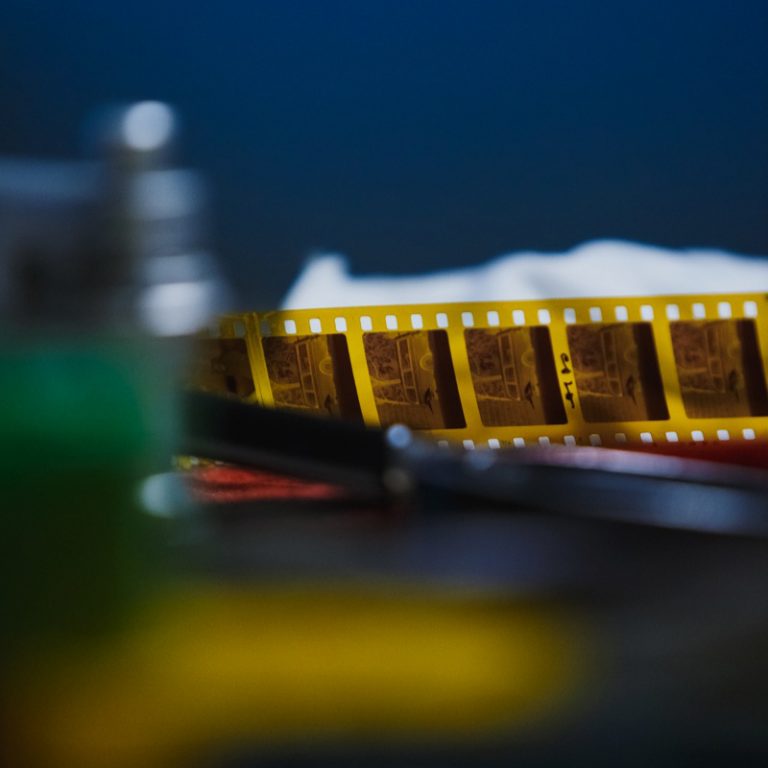Until 2006, almost all films screened in Ukrainian theatres were exclusively dubbed in Russian, and few could have ever imagined that dubbing in Ukrainian was possible. And, while by 2014 few Ukrainian movies were successfully making film distribution deals, now they are among box-office leaders. A few years ago a film institution with a vision to preserve and popularise Ukrainian films also began actively contributing to the development of Ukrainian cinema. Its name is the Dovzhenko Centre.
The Oleksandr Dovzhenko National Centre (Dovzhenko Centre), founded in 1994, is Ukraine’s largest film archive. It holds more than 6,000 Ukrainian and foreign films. During the time of Soviet Union, the centre was housed by the Kyiv Film Copy Factory, which was the only Ukrainian film-making factory and also the largest one in all of Europe. Nowadays, the Centre consists of film storage, a film copy laboratory, the Museum of Cinema, film archives, media library and its own performance hall. The Dovzhenko Centre’s main purpose is to preserve and promote national cinema. In 2015 the Centre started transforming its industrial complex into a modern open public space. Since then, Dovzhenko Centre has also run various artistic initiatives and become a popular venue for cultural events.

The Art-cluster. Ivan
Since 2014, Ivan Kozlenko has been the Head of the Dovzhenko Centre. During this time he fulfilled his dream — to turn the state’s film archive into a platform for contemporary art. Nowadays, Dovzhenko Centre is a true art-cluster that has long since reached beyond film archive boundaries. The Centre houses multiple businesses and artistic projects such as the “Wild Theater” (NGO “The Sixth Floor”), the music laboratory “KoRa”, the art workshop “Institution of Unstable Thoughts”, the bookshop “Dovzhenko.books.coffee.cinema”, the choreographic studio “Ruban Production ITP” and the cafe “Ether”.
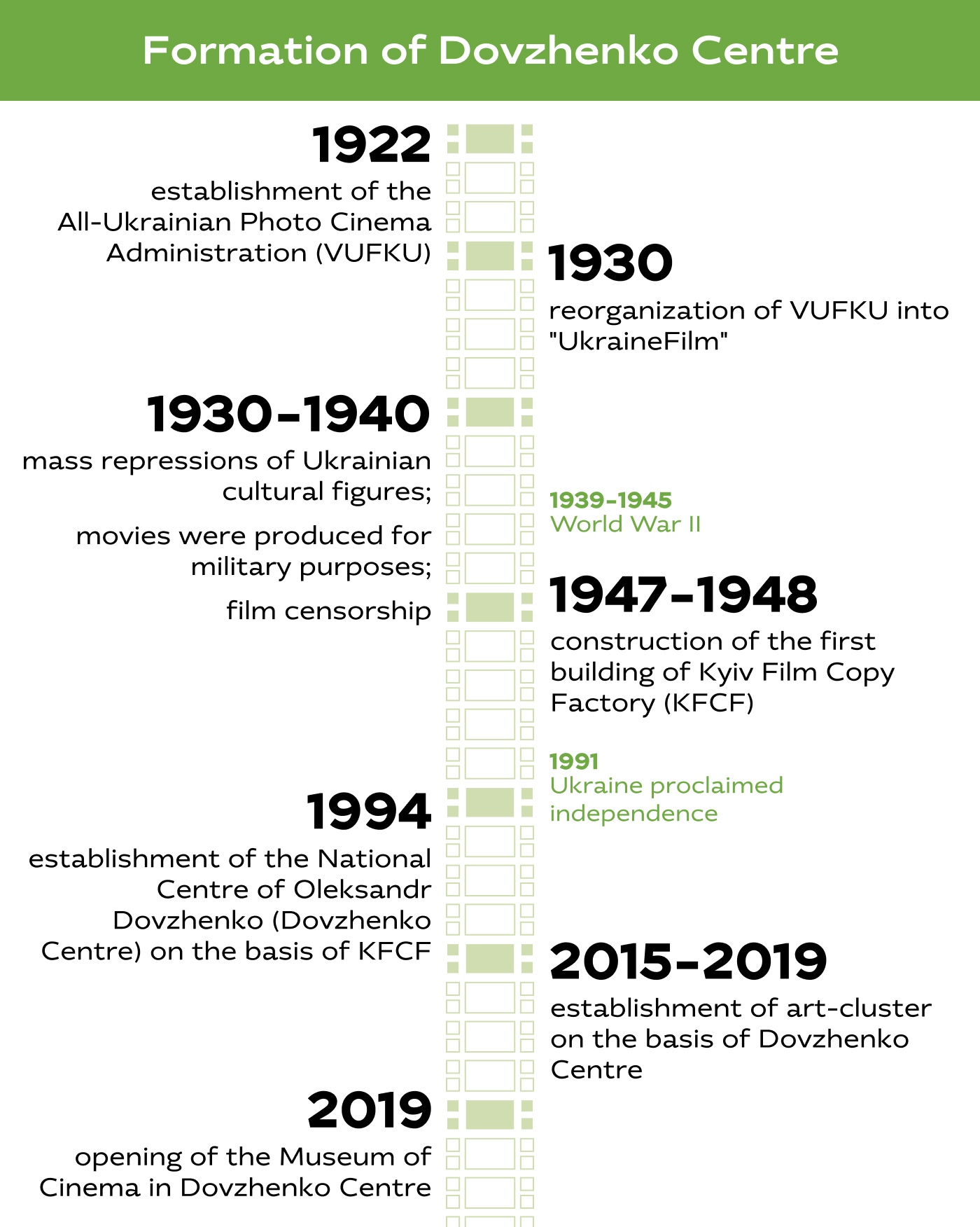
The Kyiv Film Copy Factory was first built in the 1930s and then destroyed during World War II. In 1947-1948 it was rebuilt by prisoners of war and later became a part of the Dovzhenko Centre. The entire factory complex was rebuilt in the typical Soviet style, as reflected in its architectural design and functional use of space. Industrial buildings with large workshops were created for copying, printing and storing films. Of course, the site was not open to the public. Ivan wanted to revamp the space: make it an open and bright place with services that cater better to the needs of visitors:
“Our aim was to make the archive accessible for all, including people with disabilities. By providing ramps and elevators, so that everyone could access the different wings of the high-rise building.”
Ivan Kozlenko started working at the Centre in 2011 as the Assistant Director. After a change in leadership, he applied for the position of Director General. Ivan was born in Odesa and has a degree in philosophy. For three years he worked at the Grekov Odesa Art School. In 2002 he founded a new literary magazine “A Square of Art Projects ‘Nervometer’”, and the Eastern Europe’s biggest silent films festival “Silent Nights”.
Together with a new director, the team’s first task was to redefine the institution’s mission. Previously, the Centre had never gone beyond common and general practices — they stored rolls of films and made money from copying them. In 2011 it was still operating exactly as it had during Soviet times: making copies that were mostly ordered by the state for film releases. When Ukraine was still part of the Soviet Union and up until 1991, they received copy orders from the government that was supporting film distribution in Ukraine, Moldova and Belarus. After gaining independence, they made copies for film distribution in Ukraine only. Copies were also printed for Ukrainian private filmmakers and film distributors. However, due to the transition to digital technology, the film factory fell in its importance and source of income.
It was important for the whole staff to understand the institute’s new goals and roles. In order to convey this, Ivan Kozlenko began introducing reforms. First and foremost included changing the general “factory mindset” of the employees.
“It used to practically be a whole town! And then the workers saw how it was continuously collapsing. And what did they think? ‘Well, someone else has to come and fix it.’ You know? It’s this type of mindset, this mentality has to change. But no one except us can change it. So in that sense we have simply realised that this is one of our purposes.”

Currently there are 50 people working at the Dovzhenko Centre. When Ivan Kozlenko was forming a new team, he had to fire almost the same amount, and brought on new members that embraced the different mindset and attitude necessary to realise the institute’s new vision. The few employees who remained were those who understood the global tasks the Centre faced and did not use the excuse “but that’s not my job” to avoid doing things that needed to be done such as cleaning out and decluttering the entire premises or taking the rubbish out. Some considered such work degrading, so only the people who already thought differently and were committed to moving forward towards a new common goal stayed on at the institute.
It was difficult to say goodbye to those who had been working at the Centre for 50 years and who were crying considering that they had nowhere to go. Ivan explains that he had no choice and publicly expressed:
“We will either all perish or will have to keep only a fraction of the staff. Those who are ready to move forward with me have to understand that they will not be able to sit by a cold radiator drinking tea and think that they get paid just by crossing the institute’s doorstep.”
With these people, Ivan Kozlenko has begun to change everything. The cinema archive, where original films’ documentation is preserved, used to simply be a small sub-section of the film laboratory. But now it has grown to take over the entire laboratory. Since 2017, the film institute ceased printing films for broader circulation and only makes reference copies for lifelong storage. The new team also ended the leases of the businesses that were renting space at the Centre, such as a storage facility, a driving school, and other shops and offices. The team’s guiding principle was to make the site a cultural institution where new projects and new content are constantly created. Previously, all letters written in foreign languages that the Centre received were simply discarded, but the new staff includes an international division that is capable of accepting the challenge to improve international communications as well.
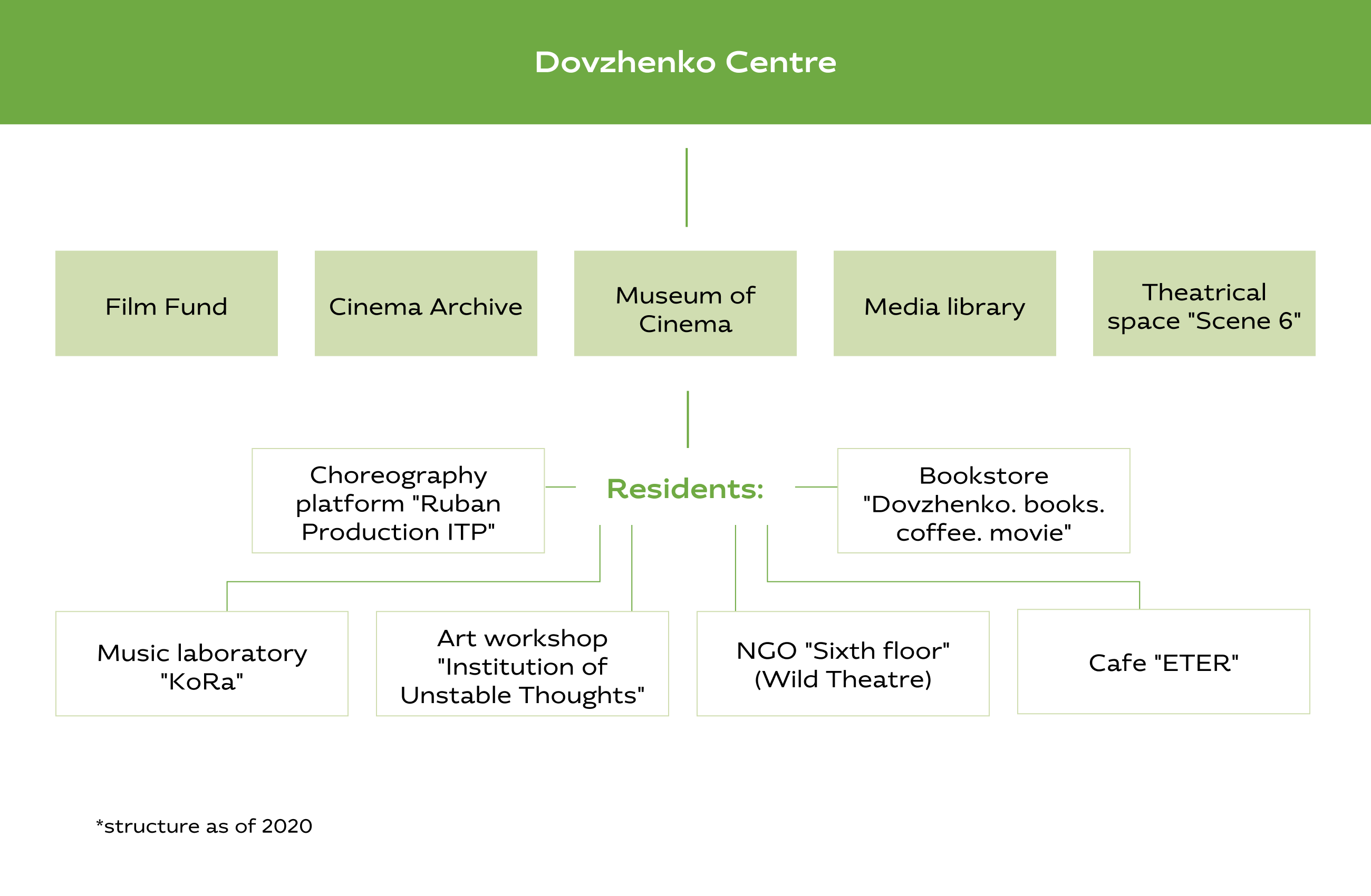
Today the Dovzhenko Centre actively promotes Ukrainian cinema internationally. It took part in organising Ukrainian stands at the European Film Market when it attended the Berlin International Film Festival. It has also screened retrospectives of Kira Muratova in Australia, Argentina and the Karlovy Vary International Film Festival, and has screened other Ukrainian retrospectives in France, Germany, Slovakia and Great Britain. Ivan talks about how number of these events and screenings of Ukrainian films has increased annually:
“Now overseas screenings have become regular. We plan around 30 of our own events per year and also give the movies to other organisations that conduct 60-70 screenings. This is considerable public exposure for Ukrainian archival cinema within the international context.”
The most crucial challenge that the institute faces currently, as Ivan sees it, is to ensure that even though they have a routine in place, they continue to provide content that is both creative and impressionable in order to keep people interested in what they do:
“We need to do something that goes beyond simply fulfilling our basic work obligations — we need to do something that always redefines the self. We need people to simply know that Dovzhenko Centre is a part of the city’s cultural map, a place where you can find thought-provoking entertainment.”

A Film Copy Laboratory. Oleksandr
The Dovzhenko Centre’s Laboratory for copying films is the only such laboratory in Ukraine. Here they scan tapes and make digital copies of them. For instance, when the archive receives a new film from abroad, the tape is scanned and later can be transferred to a filmstrip.
Oleksandr Bertman, the head of the film laboratory, explains how working with the tape often requires not only scanning, but also colour and sound correction, cleaning and restoration. And so, the whole process can take from several weeks to several years. Around ten feature films are scanned per year.
“First, we separately scan the image and then the soundtrack. When we combine the digital picture with the sound, we get this ‘single package’ as a result — the movie.”
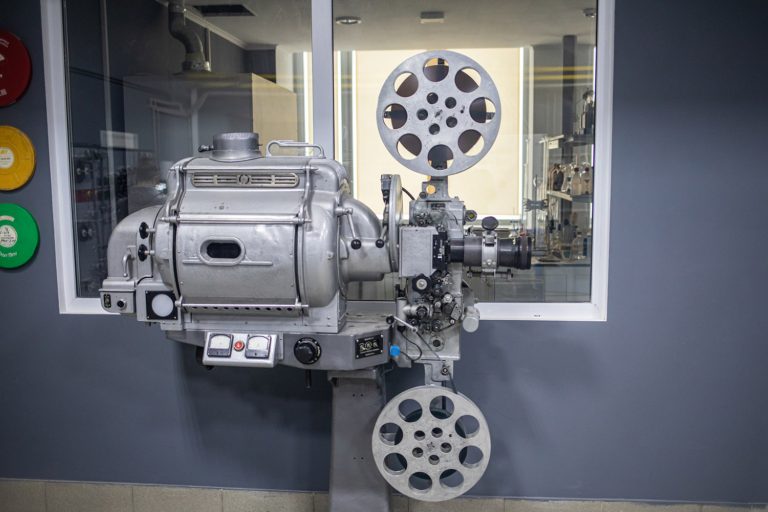
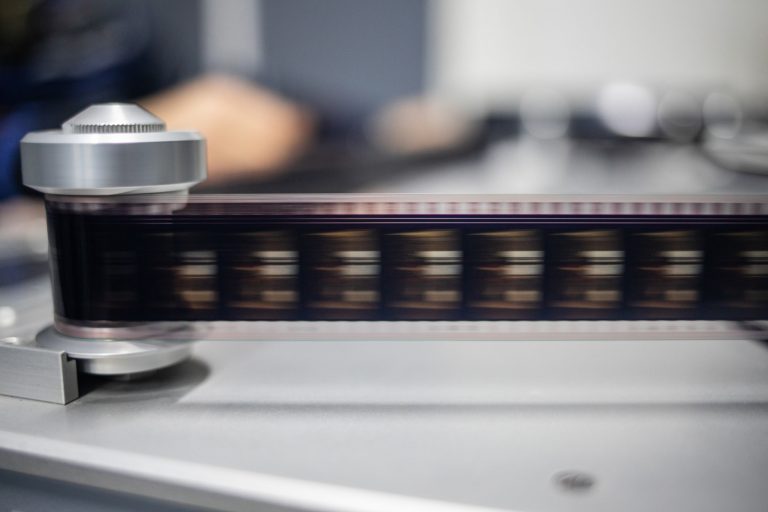
slideshow
In its digital format, a film is a source material. It can be printed on film stock or converted into other formats that can then be shown in cinemas and at festivals. The film is processed in the darkroom on three machines. The machines all perform the same function, but differ in the volume and chemical compositions used.
The first machine develops the negative film that is then edited. After developing the negative film, it’s important not to do anything else with it, since if it is damaged the original material will be lost. So there is always an internegative made from the original negative film, and all subsequent work is done using the copy.
Internegative
A duplicate of the negative film created to be used for all future copies so as to preserve the original copy.The second machine is the optical one. It develops black and white images as well as optical sound.
Optical sound
A soundtrack which is an integral part of the feature film.The final stage uses a machine that develops the colour positive film. It produces the final material with a finished colour image and sound. After that, the film is ready for public screening in cinemas.
The laboratory is mostly used for scanning archive materials, but there are exceptions sometimes:
“Archival negative films are scanned here, but occasionally we print modern films as well. For example, we printed the Ukrainian films ‘Cyborgs: Heroes Never Die’ and ‘Ivan Syla’ (‘Ivan The Powerful’ — tr.) for use in cinemas.”
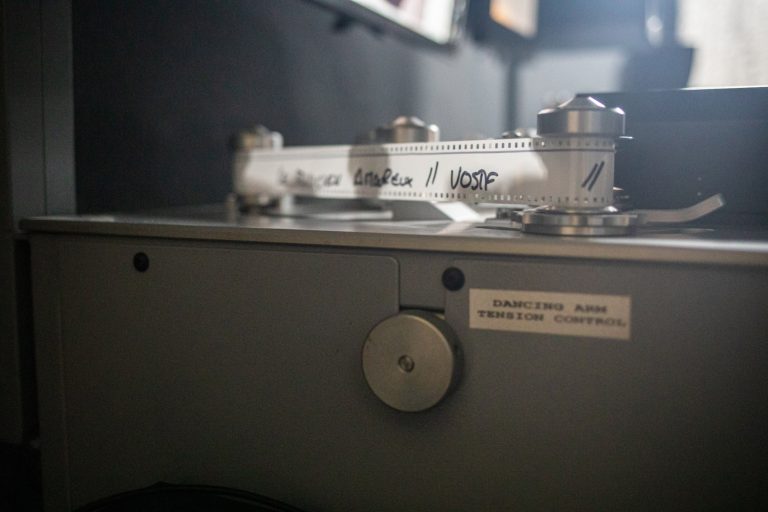
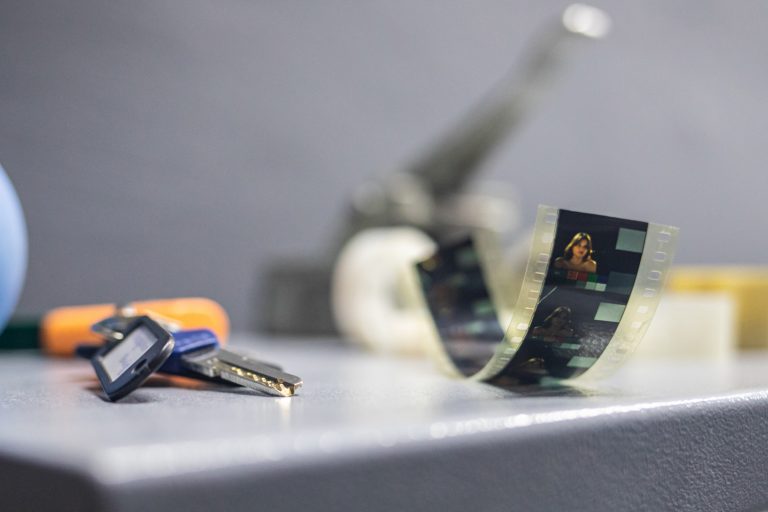
slideshow
Sometimes Dovzhenko Centre gets commercial requests to process films, but this happens rarely since the process is quite expensive. The chemical solutions used in the machines cost around $2,156 US Dollars (60 thousand hryvnias — ed.) alone, and this doesn’t take into account the additional costs of processing the material. The process itself is time consuming and very slow:
“If you calculate the processing time, from preparing the machines to developing the film, it takes around 16 hours. When dealing with large volume circulations, we put in place a non-stop production, since the development process shouldn’t be stopped once it has already started. Previously, when the Centre operated as a film copy factory, it actually did work 24/7; by using a three shift work schedule it produced up to 2 million film prints a year.”
The Dovzhenko Centre specialists prepare solutions for the machines themselves. They only buy specialised solutions for initial filling of a machine.
Quality checks on the filmstrips are carried out once every four or five years. In the case that any damages are found, the tape is then restored. Mould poses the biggest danger to filmstrips. The chemical reagent paraformaldehyde helps to prevent mould growing on the filmstrips. Paraformaldehyde is added to the box with the film and left to evaporate for two weeks. After that, the film is washed and stored separately. All information about the filmstrip is kept in the film case, such as an Editing Decision List (chronological description of the film by frame and timecode coordinates), musical information, annotations on the tape, and marks of inspectors.
The specialists who work with the film in the laboratory are truly unique, and they have no one to whom they can pass on their knowledge. Nina Stepanova, the head of Dovzhenko Centre Film Archive says that there is little interest in the profession amongst the younger generation, and that there are no places to even learn the profession anymore:
“We have only one young specialist — Olia. The rest of the people have been working here for 40-50 years, since the time that the Centre was a film factory, and they have a lot of experience handling the filmstrips. It’s a problem, since the Film Archive exists and will still exist in the future, so the need for this profession won’t disappear. Maybe, this is something that the government should handle.”

The Film Archive. Nina
The Dovzhenko Centre Film Archive consists of 56 thousand raw film materials (as a negative or its duplicate — an internegative, — optical sound and a reference copy — ed.). These raw materials make up the Archive’s nearly 6 thousand films collection. The most attention is given to the Ukrainian made films. Though around 4.5 thousand of the materials in storage are foreign-made films including American, Mongol, Lithuanian amongst others.
A reference copy
A positive copy that is not used for film distribution.If the tapes are properly kept, they can be preserved for up to 500 years. There is one filmstrip in the Archive that dates back to 1909. The storage life of the film depends on two factors: humidity and room temperature. Therefore every working day at the Film Archive begins with turning on germicidal lamps and fixing both the temperature and humidity levels.
Nina Stepanova has been working with the filmstrips for 50 years already:
“Maybe, after the introduction of new technologies, everything will be converted into another format. Although for me personally, the physical filmstrip is much more familiar and clear than digital, although I wouldn’t stop using digital film. It’s like with lighting: in the olden days everyone was using candles, while today they are mostly for decor or a good mood. But candles are still being used!”
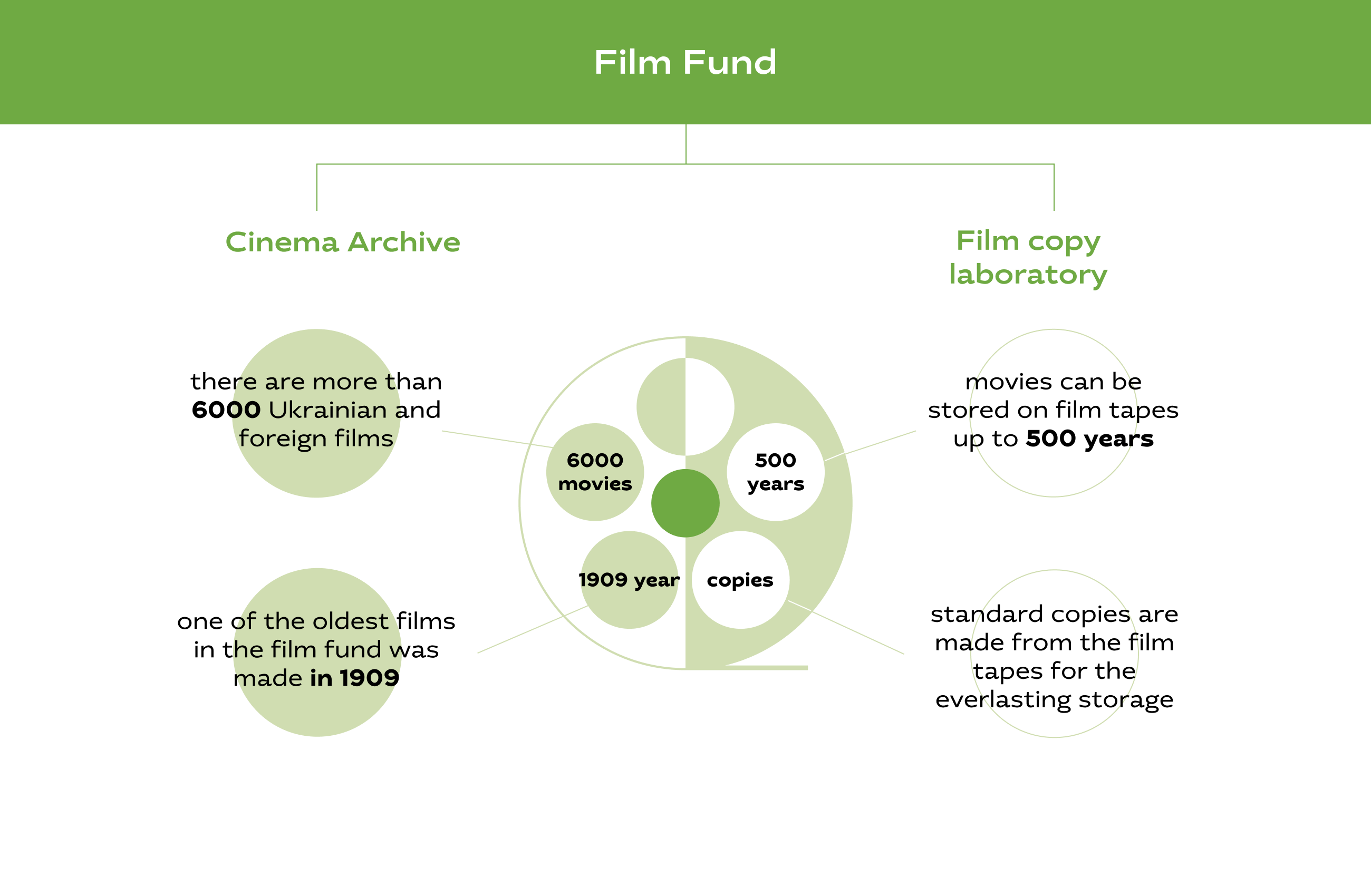
The primary task of the Film Archive is to preserve material on any kind of medium, so that you can always print a copy and then digitise it. Filmstrrips from the film studios, both Odesa’s and Dovzhenko’s, are delivered in different states, so the first thing that laboratory specialists working with the films have to do is inspect them and then restore, wash, and add the paraformaldehyde. After this procedure the material is then re-inspected.
Nina Stepanova started working in the Centre as an inspector in 1969. Now the head of the Film Archive, she refers to her work as “the other side of the cinema” and recalls with excitement:
“When you are 18-19 years old, it is interesting to have access to so many films. The financial aspect played absolutely no role in this. Somehow, you stick to it and that’s all. How? It is difficult to explain. Once you enter the film industry, you never leave.”
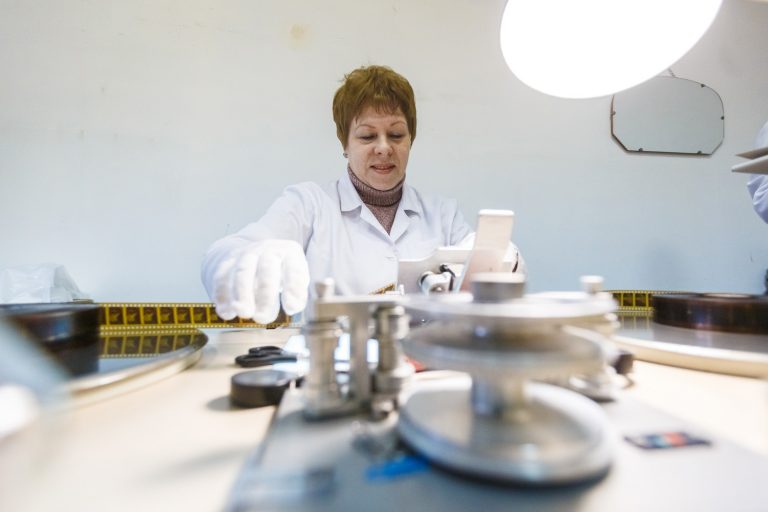
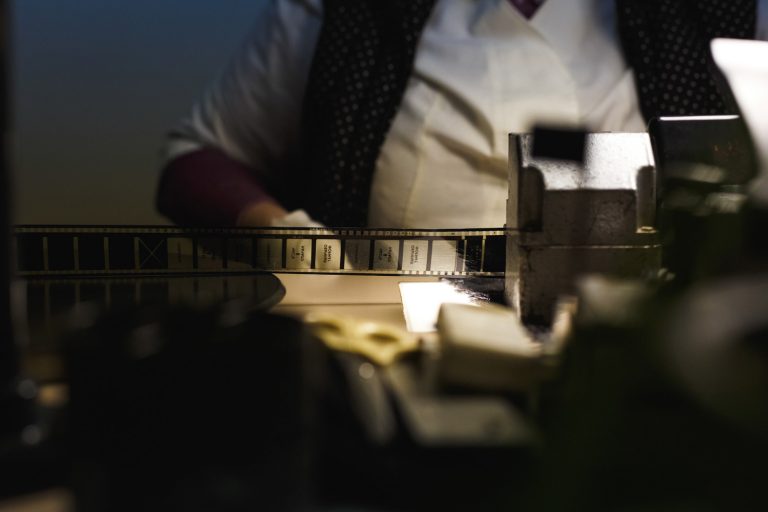
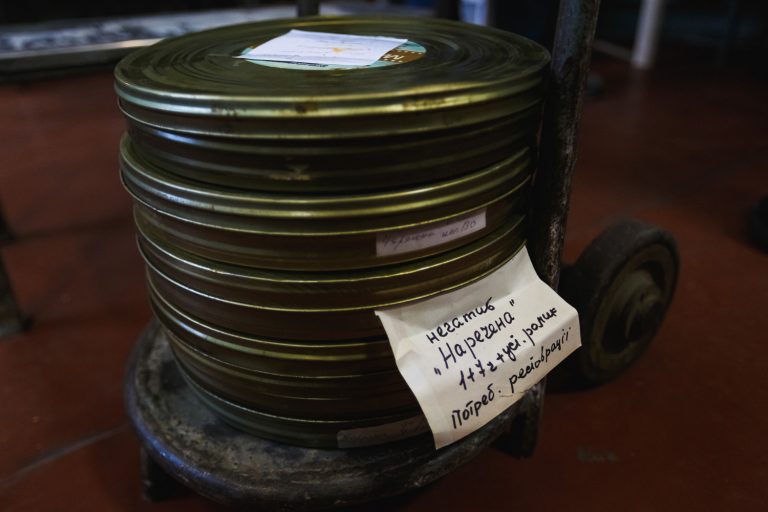
slideshow
However, understanding the true value of such a job comes later:
“This work is needed although it’s usually underestimated. Filmmakers or producers may value what we do, when they find their movies: ‘Ah! It is still preserved’ — and that’s it. But at some stage you realise that you are doing something for the current and future generations.”

The Cinema Museum. Olena
It took four years to create the first cinema museum in Kyiv. There were two main tasks, typical for most Ukrainian museums, that had to be done: providing good service and creating good-quality content. First, the ground floor of the Centre was cleared for the exposition and also the toilets for visitors were built. All of the infrastructure had to be made from scratch. Now the cinema museum has a comfortable reception area, cinema lecture hall, and children’s space.
At the same time the museum’s concept had to be developed and implemented. Since the modern museum has to know how to make its content interesting — it shouldn’t just conduct master-classes and events but make sure both relate to the museum’s collection.
Simultaneously the Centre’s specialists were working on an exhibition dedicated to the All-Ukrainian Photo Cinema Administration (abbreviation in Ukrainian — VUFKU — tr.), the state’s central cinematographic organisation that operated from 1922 to 1930. VUFKU’s pivotal role in the development of Ukrainian film was the reason the project was chosen as the premiere exhibition for the cinema museum when it opened in September 2019. At that time, the exhibits from the Dovzhenko Centre and other museums and institutions all united in a joint exhibition about the achievements of Ukrainian cinematography. Here you were able to see unique shots, film equipment and video chronicles. The museum director, Olena Honcharuk, tells that VUFKU is a little-known phenomenon in Ukrainian culture:
“At schools and universities they barely pay any attention to VUFKU. We know names such as Dovzhenko, Kaufman or Dzyga Vertov, but nothing more in detail. That’s why VUFKU may be considered as partially lost both as a phenomenon and physically — we lost about 54% of the feature films made in that period.”
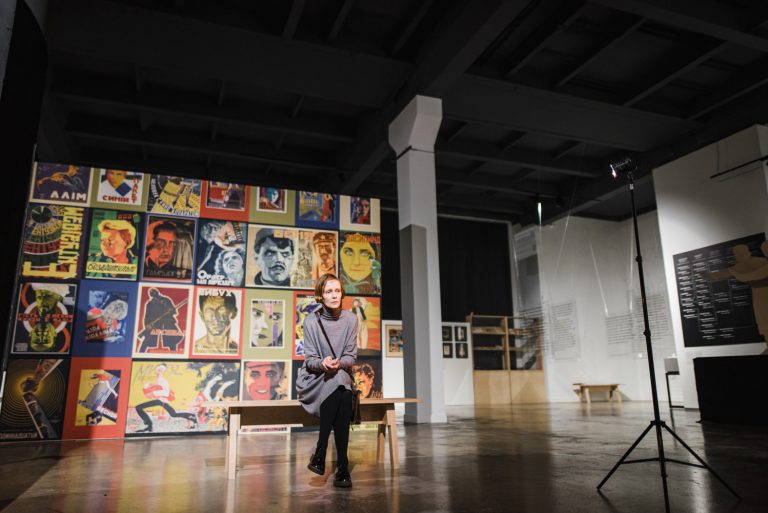
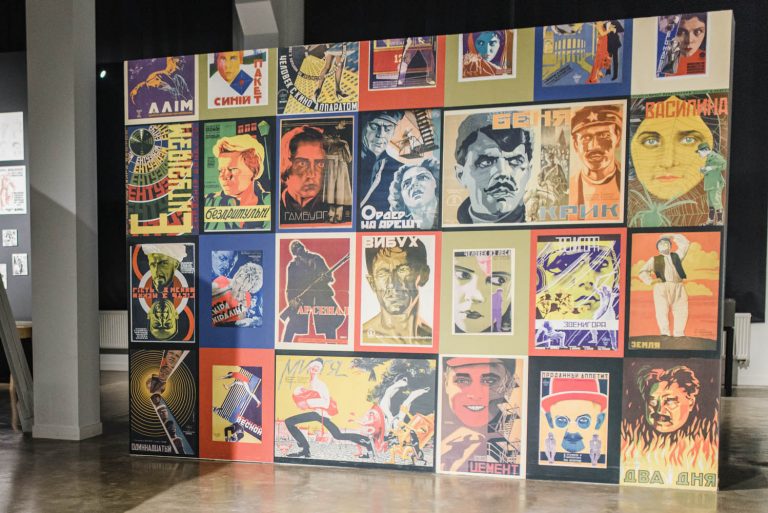
slideshow
During the almost 8 years of VUFKU’s existence, 120 films were made. The gallery titled “Lost and Found” at the cinema museum starts with a poster wall. As Olena says, these posters are great examples of design, typography, and historical references:
“Posters don’t only display a film’s title, from a poster you can start unraveling information concerning a film. Sometimes the name in the poster led us to discover the Ukrainian film in a foreign film archive in Germany, Japan or Gosfilmofond in Russia.”
VUFKU has been called a great film pavilion because its studios and offices were in Yalta, Odesa, Kharkiv, and Kyiv. Olena Honcharuk shows a personnel map of actors and others involved with the filming process and script writing. VUFKU consisted mostly of people who were not professionals by education, but learned the craft on the go. They were sculptors, architects, engineers and inventors. Over the period of VUFKU’s existence they created their own publication, the “Kino” magazine (“Cinema” — tr.), and a school for training specialists:
“The Ukrainian film industry grew out of literature and worked with texts by famous writers from the 1920s such as Mykhaylo Semenko, Geo Shkurupii, Mykola Bazhan. Even Mayakovsky gave VUFKU several scripts. However, not all of these films were preserved, just as many of the ones that were never completed and have since been lost.”
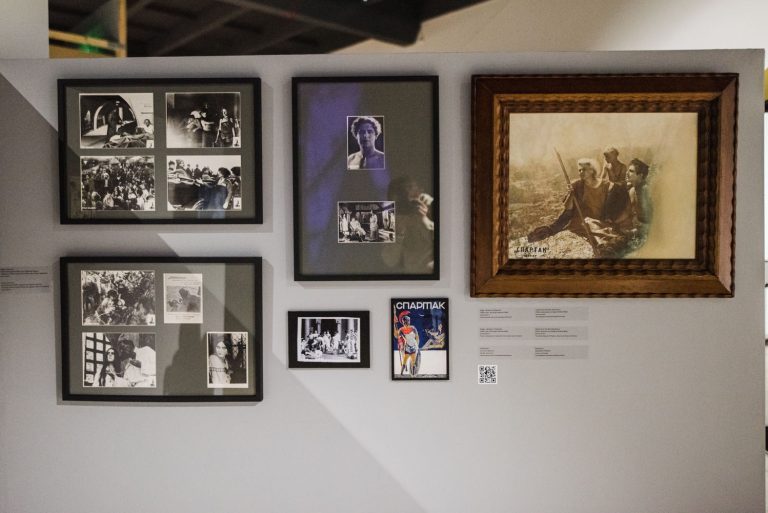
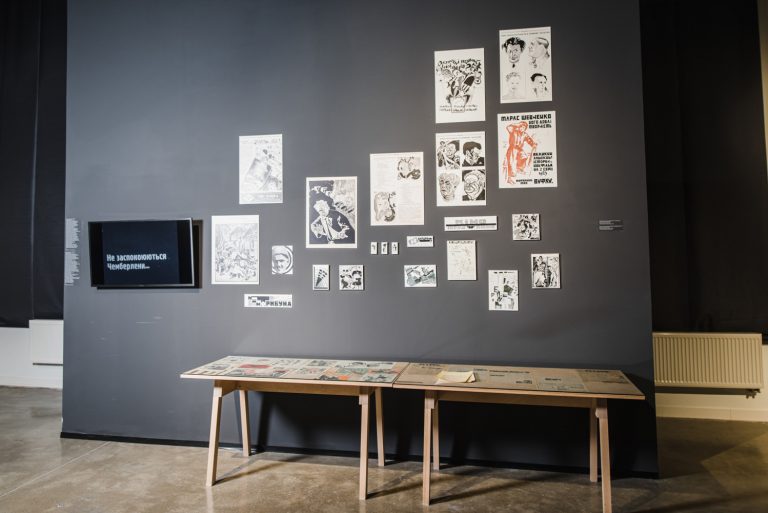
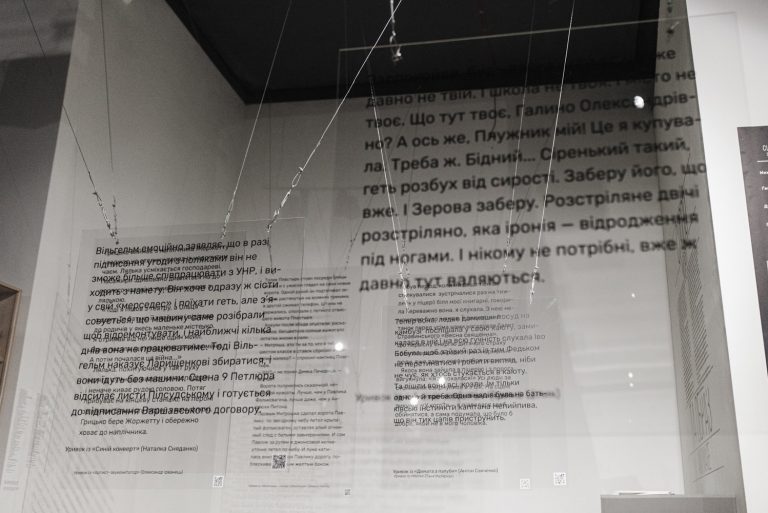
slideshow
Olena Honcharuk tells that it was important for the exhibition to show just how relevant these texts still are today. In order to do so, they enlisted the support of modern Ukrainian writers like Iryna Tsilyk, Anton Sanchenko, Oleksandr Irvanets, Oleksii Nikitin. They created librettos by bringing artistic texts and scripts from the 20s back to life. In the 20s, librettos accompanied film screenings so the viewers could clearly understand what was being screened. Moviegoers would receive a leaflet with a description of the film and how to watch it. Printed on special transparent panels are excerpts from six such adapted pieces:
“I think that some writers have already started to think about really creating a contemporary movie out of these adaptations. Even someone like Ira Tsilyk, who is also a director, feels that they have great potential as film material.”
As a result of the Soviet Union’s Ukrainisation policy, VUFKU acquired quite a privileged status. Its members had absolute freedom in the creative process. Although within the reality of the Soviet Union it could not last for long and ultimately authorities began to impose restrictions on what kind of creative material the artists could produce. As a result of the increasing control of the authorities and the curtailment of all creative processes, in 1930 VUFKU stopped functioning:
Ukrainisation
A Soviet Union policy in the 1920s aimed at creating favorable conditions for the spread of Ukrainian language and culture that catered to ethnic Ukrainians within the territories of the Soviet Union.“The Administration was dissolved and inherited by “Ukrainafilm” (“Ukraine film” — tr.), the institution, which was fully subordinated to Moscow. All filmstrips and films made in the 1920s were brought to Moscow. It is a big and complicated task for us today — to return them back to Ukraine, since the rights to those films actually belong to our country.”

In one of the museum exhibition halls there is a digital installation by Anton Pryhodko — a video projection on the wall. When there are no viewers in this “conditional cinema” room, the picture on the screen gets distorted and hard to recognise. However, when there is at least one person in the room, the picture goes back to normal and you can watch the movie as usual. What the installation implies is that cinema needs a viewer. Olena Honcharuk says that films are always working for the viewer and a reciprocal interaction is key:
“If there are no viewers and nobody knows about the movie, then it’s as if the film never even existed. But as soon as there is at least one interested person, the movie starts working. Because it is simply a mutual process, a film isn’t just the work of the producer, operator and shooting group. It is also about the contribution of those who are watching.”

